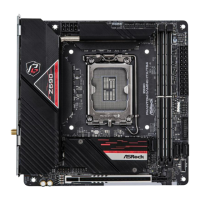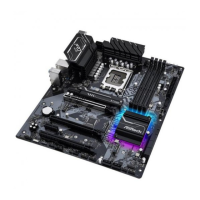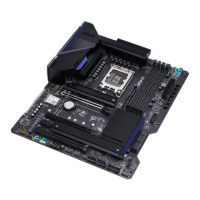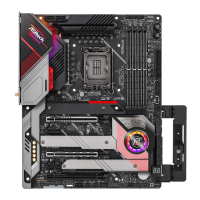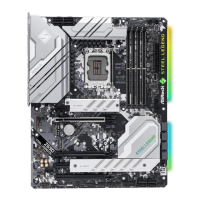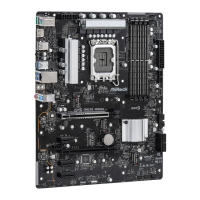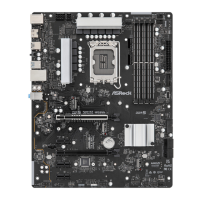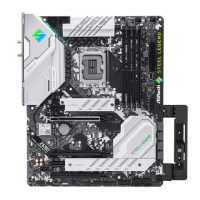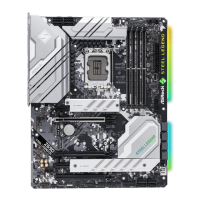Do you have a question about the ASROCK Z690 Taichi and is the answer not in the manual?
Lists all items included in the ASRock Z690 Taichi motherboard package for the user.
Detailed technical specifications of the ASRock Z690 Taichi motherboard, including CPU, Chipset, Memory, and Expansion Slots.
Diagram and identification of key components and connectors on the ASRock Z690 Taichi motherboard.
Description and layout of the Input/Output panel ports on the ASRock Z690 Taichi motherboard.
Details about the 802.11ax Wi-Fi 6E module and the ASRock WiFi 2.4/5/6 GHz antenna.
Instructions for installing the graphics card holder to support heavy graphics cards.
Guide for installing the 3010 cooling fan with bracket to the motherboard.
Instructions for installing the 4010 cooling fan bracket to the motherboard for enhanced cooling.
Steps for installing the wireless dongle USB bracket to provide additional USB 2.0 ports.
Important safety and handling precautions to take before installing motherboard components.
Step-by-step guide for correctly installing the CPU into the motherboard socket.
Instructions on how to properly install the CPU fan and heatsink for effective cooling.
Guide for installing DDR5 memory modules into the DIMM slots, including dual channel configuration.
Information on the PCIe slots, their configurations, and guidelines for installing expansion cards.
Explanation of jumper settings, specifically the Clear CMOS jumper (CLRMOS1).
Details and diagrams for connecting system panel components and other onboard headers.
Description of the motherboard's smart switches: Power Button, Reset Button, and Clear CMOS Button.
List of Dr. Debug codes and their corresponding descriptions for system troubleshooting.
Guide for installing and configuring multiple graphics cards using AMD CrossFireX technology.
Steps for installing necessary drivers and software, including AMD Catalyst Control Center for graphics.
Detailed instructions for installing an M.2_SSD (NGFF) module in the M2_1 slot.
Detailed instructions for installing an M.2_SSD (NGFF) module in the M2_2 slot.
Detailed instructions for installing an M.2_SSD (NGFF) module in the M2_3 slot.
Guide on how to install necessary drivers from the support CD for motherboard functionality.
Overview and usage of ASRock's A-Tuning utility for system monitoring, tuning, and fan control.
Guide to using the ASRock Live Update & APP Shop for software downloads and system updates.
Description of the Nahimic audio software functions for enhancing system audio performance.
Guide for customizing RGB lighting effects on the motherboard using ASRock Polychrome SYNC utility.
Explains how to enter and navigate the UEFI Setup Utility for system configuration.
Description of the EZ Mode screen, providing a dashboard of current system status and basic options.
Details on accessing and navigating the Advanced Mode, including the UEFI Menu Bar and Navigation Keys.
Overview of the Main screen in the UEFI Setup Utility, displaying system information and favorite items.
Guide to configuring overclocking features for the CPU, memory, and other system components.
Access to various utility tools such as ASRock Polychrome RGB, RAID installer, and SSD tools.
Monitors system hardware status, including CPU/motherboard temperatures, fan speeds, and voltages.
Settings for system security, including supervisor/user passwords, secure boot, and platform trust technology.
Configures boot order, fast boot options, CSM, and PXE boot policies.
Options for saving changes, discarding changes, and loading default UEFI settings before exiting.
Detailed settings for CPU configuration, including core control, hyper-threading, and power saving features.
Settings related to the chipset, including PCIe link speeds, memory allocation, and integrated graphics control.
Configuration options for SATA controllers, storage modes, and hard disk monitoring (S.M.A.R.T.).
Options for enabling and configuring Intel Thunderbolt support, including boot and USB features.
Settings for ACPI (Advanced Configuration and Power Interface) features, such as suspend modes and wake-up events.
Configuration options for USB functionality, including hand-off support and re-driver settings.
Settings for trusted computing features, including BIOS support for security devices and PCR banks.
Lists all items included in the ASRock Z690 Taichi motherboard package for the user.
Detailed technical specifications of the ASRock Z690 Taichi motherboard, including CPU, Chipset, Memory, and Expansion Slots.
Diagram and identification of key components and connectors on the ASRock Z690 Taichi motherboard.
Description and layout of the Input/Output panel ports on the ASRock Z690 Taichi motherboard.
Details about the 802.11ax Wi-Fi 6E module and the ASRock WiFi 2.4/5/6 GHz antenna.
Instructions for installing the graphics card holder to support heavy graphics cards.
Guide for installing the 3010 cooling fan with bracket to the motherboard.
Instructions for installing the 4010 cooling fan bracket to the motherboard for enhanced cooling.
Steps for installing the wireless dongle USB bracket to provide additional USB 2.0 ports.
Important safety and handling precautions to take before installing motherboard components.
Step-by-step guide for correctly installing the CPU into the motherboard socket.
Instructions on how to properly install the CPU fan and heatsink for effective cooling.
Guide for installing DDR5 memory modules into the DIMM slots, including dual channel configuration.
Information on the PCIe slots, their configurations, and guidelines for installing expansion cards.
Explanation of jumper settings, specifically the Clear CMOS jumper (CLRMOS1).
Details and diagrams for connecting system panel components and other onboard headers.
Description of the motherboard's smart switches: Power Button, Reset Button, and Clear CMOS Button.
List of Dr. Debug codes and their corresponding descriptions for system troubleshooting.
Guide for installing and configuring multiple graphics cards using AMD CrossFireX technology.
Steps for installing necessary drivers and software, including AMD Catalyst Control Center for graphics.
Detailed instructions for installing an M.2_SSD (NGFF) module in the M2_1 slot.
Detailed instructions for installing an M.2_SSD (NGFF) module in the M2_2 slot.
Detailed instructions for installing an M.2_SSD (NGFF) module in the M2_3 slot.
Guide on how to install necessary drivers from the support CD for motherboard functionality.
Overview and usage of ASRock's A-Tuning utility for system monitoring, tuning, and fan control.
Guide to using the ASRock Live Update & APP Shop for software downloads and system updates.
Description of the Nahimic audio software functions for enhancing system audio performance.
Guide for customizing RGB lighting effects on the motherboard using ASRock Polychrome SYNC utility.
Explains how to enter and navigate the UEFI Setup Utility for system configuration.
Description of the EZ Mode screen, providing a dashboard of current system status and basic options.
Details on accessing and navigating the Advanced Mode, including the UEFI Menu Bar and Navigation Keys.
Overview of the Main screen in the UEFI Setup Utility, displaying system information and favorite items.
Guide to configuring overclocking features for the CPU, memory, and other system components.
Access to various utility tools such as ASRock Polychrome RGB, RAID installer, and SSD tools.
Monitors system hardware status, including CPU/motherboard temperatures, fan speeds, and voltages.
Settings for system security, including supervisor/user passwords, secure boot, and platform trust technology.
Configures boot order, fast boot options, CSM, and PXE boot policies.
Options for saving changes, discarding changes, and loading default UEFI settings before exiting.
Detailed settings for CPU configuration, including core control, hyper-threading, and power saving features.
Settings related to the chipset, including PCIe link speeds, memory allocation, and integrated graphics control.
Configuration options for SATA controllers, storage modes, and hard disk monitoring (S.M.A.R.T.).
Options for enabling and configuring Intel Thunderbolt support, including boot and USB features.
Settings for ACPI (Advanced Configuration and Power Interface) features, such as suspend modes and wake-up events.
Configuration options for USB functionality, including hand-off support and re-driver settings.
Settings for trusted computing features, including BIOS support for security devices and PCR banks.
| Audio chip | Realtek ALC1220 |
|---|---|
| Certification | FCC, CE, ErP/EuP |
| Component for | PC |
| Motherboard chipset | Intel Z690 |
| PC health monitoring | CPU, FAN, LED, Temperature, Voltage |
| Audio output channels | 7.1 channels |
| Motherboard form factor | ATX |
| Motherboard chipset family | Intel |
| Windows operating systems supported | Windows 10 x64, Windows 11 x64 |
| S/PDIF out port | Yes |
| WiFi-AP antenna jack | 2 |
| USB 2.0 ports quantity | USB 2.0 ports have a data transmission speed of 480 Mbps, and are backwards compatible with USB 1.1 ports. You can connect all kinds of peripheral devices to them. |
| USB 3.2 Gen 1 (3.1 Gen 1) Type-A ports quantity | 4 |
| USB 3.2 Gen 2 (3.1 Gen 2) Type-C ports quantity | 0 |
| Number of SATA III connectors | 6 |
| BIOS type | UEFI AMI |
| ACPI version | 6.0 |
| BIOS memory size | 256 Mbit |
| System Management BIOS (SMBIOS) version | 2.7 |
| RAID levels | 0, 1, 5, 10 |
| Supported storage drive types | HDD & SSD |
| Supported storage drive interfaces | M.2, SATA III |
| Number of M.2 (M) slots | 3 |
| Maximum resolution | 7680 x 4320 pixels |
| Parallel processing technology support | Crossfire |
| LAN controller | Intel I219-V, Killer E3100G |
| Wi-Fi standards | 802.11a, 802.11b, 802.11g, Wi-Fi 4 (802.11n), Wi-Fi 6 (802.11ax) |
| Top Wi-Fi standard | Wi-Fi 6E (802.11ax) |
| Ethernet interface type | 2.5 Gigabit Ethernet, Gigabit Ethernet |
| Memory channels | Dual-channel |
| Memory slots type | DIMM |
| Supported memory types | DDR5-SDRAM |
| Maximum internal memory | 128 GB |
| Supported memory clock speeds | 6400 MHz |
| Processor socket | LGA 1700 |
| Compatible processor series | Intel Celeron, Intel Core i3, Intel Core i5, Intel Core i7, Intel Core i9, Intel Pentium |
| Cables included | SATA |
| Harmonized System (HS) code | 84733020 |
| Weight | 1000 g |
| Depth | 244 mm |
|---|---|
| Width | 305 mm |
| Height | 70 mm |
